Chapter-9 PMA Write-up
Lab 9-1 :
Analyze the malware found in the file Lab09-01.exe using x64dbg and IDA-Pro to answer the following questions. This malware was initially analyzed in the Chapter 3 labs using basic static and dynamic analysis techniques.
Questions
- How can you get this malware to install itself?
- What are the command-line options for this program? What is the password requirement?
- How can you use x64dbg to permanently patch this malware, so that it doesn’t require the special command-line password?
- What are the host-based indicators of this malware?
- What are the different actions this malware can be instructed to take via the network?
- Are there any useful network-based signatures for this malware?
From basic analysis we know that:
- It’s a 32-bit PE
- Console app
- MD5: B94AF4A4D4AF6EAC81FC135ABDA1C40C
- SHA256: 6AC06DFA543DCA43327D55A61D0AAED25F3C90CCE791E0555E3E306D47107859
- The binary deletes itself when double clicked.
Now, let’s open it in IDA.
Overview
At begining, we see a check for the number of command-line arguments, if it lower than ‘1’ the progrm calls sub_40100, If it’s greater then it calls sub_402510
Note argc must be greater than 0 as the file name of the program is always counted
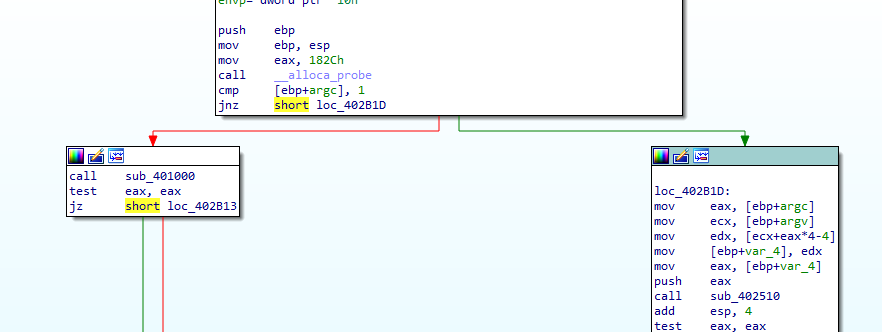
sub_40100 is calling ShellExeuteA function, but we don’t know which are acutually pushed to it
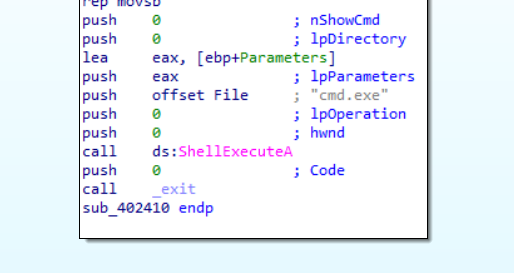
We could use x64dbg and breaking on our functionto see what does the function do.

We can see that it uses cmd.exe to execute the following command:
/c del C:\\Users\\husky\\Desktop\\Lab09-01.exe >> NUL
This command is used to delete the binary, that means that there is some command-line arguments that should be passed to make the binary works.
Reversing password
The sub_402510 function acts as a password checker, we see 5 comparison that must be satisfied in the last argument “password” so that the program runs.
After some debugging, We can obtain that the password is abcd.
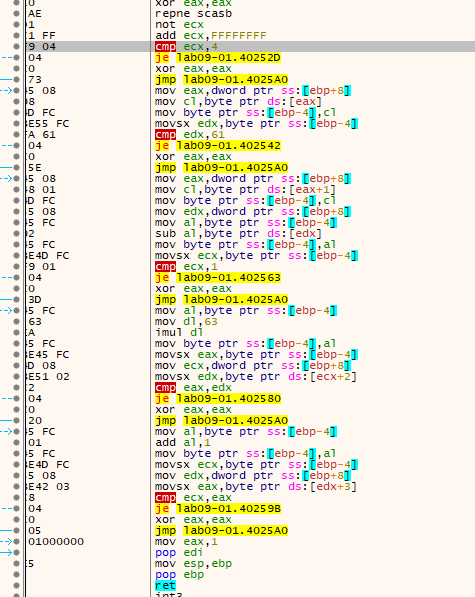
Bypassing password
To patch the malware so that we could bybass the password we may turn every je to jmp.
An alternative way is that we could simply set eax to ‘1’ then do a ret instruction like that:
B8 01 00 00 00 MOV EAX, 0x1
C3 RET
Malware options
Beside the “password” there is another argument that specifies which option will be taken.
After the password checking, the malware compares between the second argument and -in, If it’s true, the program starts to install itself.
We can find that the other options are being pushed to “mem_comp” function to be compared to our input argument one by one.




Note: “-op1” is the input I used, the other argument to “mem_comp” is the hardcoded option.
The options are:
- -in, Installs the malware.
- -re, Removes the malware.
- -c, Preforms a post-compromise activity.
- -cc, Checks current configuration in registry key.
For self installation, we have to run the malware with 2 arguments “-in” and “abcd”.
Host-base IOCs
-
The registry key used to store the malware configuration: HKLM\SOFTWARE\Microsoft \XPS.
-
The service created the name: “Manager Service.”
-
The presence of a binary at %SYSTEMROOT%\Windows\System32.
Network actions
By using IDA strings, we can notice some actions that belongs to a connection to the network in the sub_402020, these actions are:
- NOTHING, does nothing
- DOWNLOAD, uploads a file from disk to a web resource.
- UPLOAD, downloads a file from a web resource over a specified port and write it to disk
- SLEEP, puts the malware to sleep for a some milliseconds
Note: for upload and download actions, these aren’t types, The upload action is downloading to the host, and the download action is uploading to a remote host.

Network-base IOCs
http://www.practicalmalwareanalysis.comusing HTTP/1.0
Lab 9-2 :
Analyze the malware found in the file Lab09-02.exe using x64dbg to answer the following questions.
Questions
- What strings do you see statically in the binary?
- What happens when you run this binary?
- How can you get this sample to run its malicious payload?
- What is happening at 0x00401133?
- What arguments are being passed to subroutine 0x00401089?
- What domain name does this malware use?
- What encoding routine is being used to obfuscate the domain name?
- What is the significance of the CreateProcessA call at 0x0040106E?
From basic analysis we know that:
- It’s a 32-bit PE
- GUI app
- MD5: 251F4D0CAF6EADAE453488F9C9C0EA95
- SHA256: F153DFACEC09DD69809C3BBF68270A38EE3701F44220C7BF181C14A68C138133
- The binary terminates itself when double clicked.
Exploring strings First let’s look at strings using Floss:
Besides the list of importd APIs, there are no interesting strings that appear statically in the binary, but floss was able to gather some decoded strings and stackstrings
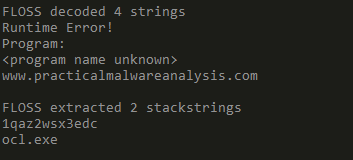
Now, let’s open it in IDA.
First, we see some values being stored in the stack segment which are corresponding to our previously mentioned stackstrings.
This is a common string obfuscation technique to make analysis more challenging.
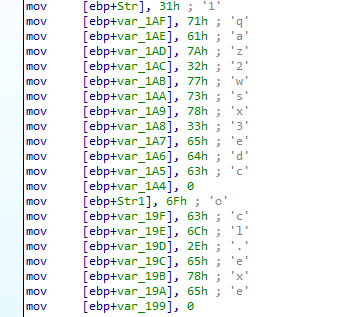
A while after a call to _strcmp function which compares between 2 arguments str1 and str2.
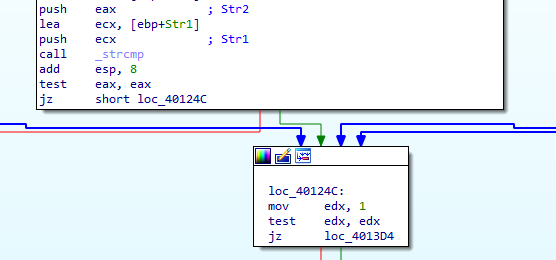
Using x64dbg we can see that the two arguments are ocl.exe and Lab09-02.exe

If the comparison is true, return value will be ‘0’ and the malware starts it functionality, If false, the the return value is ‘1’ and the malware will terminate itself.
So, To run the malicious payload, we could change file name to become ocl.exe.
After that, we see a call to WSAStartup and WSASocketA to initiates a socket conection, then a call to `sub_401089.
Using x64dbg, we can see that the 2 arguments that are pushed to sub_401089 are “0x019FD40” and “1qaz2wsx3edc”.

The sub_401089 acts as a decoding routine to decode the 1qaz2wsx3edc and store the result in memory at “0x019FD40” , the decoded string is a domain name called http://www.practicalmalwareanalysis.com.
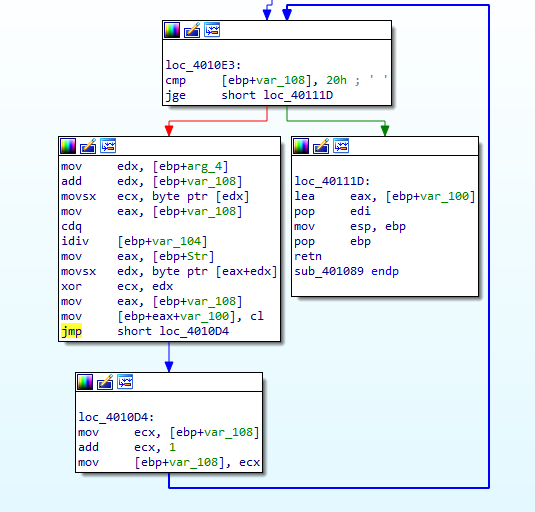

The encoding routine used to obfuscate the domain name is a XOR routine.
After that we see a call to gethostbyname and htons to establish the network to a connect API call, If the connection with C2 server was successful, the malware calls sub_401000.
Inside the sub_401000, we see a called to CreateProcessA API to creates a new process and its primary thread.
According to MSDN Page the parameters to the CreateProcessA enables it to creates a new process with the cmd.exe command line to be executed in a hidden window.
The standard input, output, and error streams are passed to the established socket to the C2.
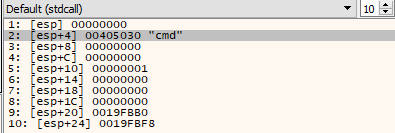
Summary
The malware acts as a Reverse-Shell allowing access to this host, and then establishes a cmd process to receive commands to execute from a C2 server.
Lab 9-3 :
Analyze the malware found in the file Lab09-03.exe using x64dbg and IDA-Pro. This malware loads three included DLLs (DLL1.dll, DLL2.dll, and DLL3.dll) that are all built to request the same memory load location. Therefore, when viewing these DLLs in x64dbg versus IDA Pro, code may appear at different memory locations. The purpose of this lab is to make you comfortable with finding the correct location of code within IDA Pro when you are looking at code in x64dbg.
Questions
- What DLLs are imported by Lab09-03.exe?
- What is the base address requested by DLL1.dll, DLL2.dll, and DLL3.dll?
- When you use x64dbg to debug Lab09-03.exe, what is the assigned based address for: DLL1.dll, DLL2.dll, and DLL3.dll?
- When Lab09-03.exe calls an import function from DLL1.dll, what does this import function do?
- When Lab09-03.exe calls WriteFile, what is the filename it writes to?
- When Lab09-03.exe creates a job using NetScheduleJobAdd, where does it get the data for the second parameter?
- While running or debugging the program, you will see that it prints out three pieces of mystery data. What are the following: DLL 1 mystery data 1, DLL 2 mystery data 2, and DLL 3 mystery data 3?
- How can you load DLL2.dll into IDA Pro so that it matches the load address used by x64dbg?
From basic analysis we know that:
- It’s a 32-bit PE
- Console app
- MD5: A90B5A068EF610C44F07ABEDDAB37D2A
- SHA256: 1FC6A471B2A46CD882246D5BDC9D5954BF8EFACF68B4E549A9756E6616848884
- The binary prints some mysterious strings when double clicked.
Now, let’s open it in IDA.
In imports window, we can see that the binary imports the following DLLs:
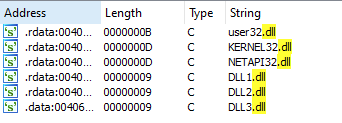
Using CFF Explorer, we can see the that all three DLLs request the base-address of 0x10000000.

In x64dbg, we can go to Symbols window to see that the assigned based-addresses of the three DLLs are loaded as following:

NOTE that: DLL3.dll is dynamicly linked which means that we have to execute the LoadLibraryA function first to be able to see where it’s been loaded.
Now let’s see what is happening in main function, first we see a call to DLL1Print function which is imported from DLL1.dll.

To see what it does, we step into it in x64dbg, we see that it calls only one function that prints it’s two parameters DLL 1 mystery data %d the number at the end is the second parameter which is the value in the address of 0x10008030.

As there is previous initialization to the value in the address of 0x10008030, then it must had been initialize in DLLMain so let’s go to it, we see that it is the ID of our current process Lab09-03.exe.

To make sure that we are right, We open Process Hacker to see that the ID of our current process Lab09-03.exe is the same to the printed number.


Now, let’s get back to main:
After the DLL1Print we find a call to DLL2Print, We step into it to see the same function the was implemented in DLL1Print which will print DLL 2 mystery data %d, so we go to DLLMain to see the value in the second parameter.

We see a call to CreateFileA to create a file under the name of temp.txt, which means that it will return an open handle to the specified file, which will be printed to our output later.

To make sure of that, We open the Handles window to see the handel for the temp.txt is EC (236 in decimal) which to equivalent to our output.
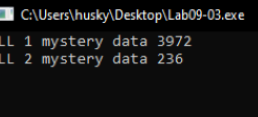

Backing to main we see a call to DLL3Print which will also print DLL 3 mystery data %d, this time the seconed parameter refers to the Memory address of ping www.malwareanalysisbook.com which is equivalent to the our output (the parameter in hex and the output is decimal).


After that we see a call to GetProcAddress and DLL3GetStructure then a call to NetScheduleJobAdd.
According to MSDN Page, The NetScheduleJobAdd is used to submits a job to run at a specified future time and date, it takes 3 parameters:
- Servername
- Buffer
- JobId

The second parameter buffer gets it’s data from the DLL3GetStructure return value, which represents a pointer to an AT_INFO structure describing the job to submit.
We can load DLL2.dll into IDA Pro in a different location by checking the
Manual Load box when loading the DLL. In the field that says Please specify
the new image base, we type 0x04E0000.
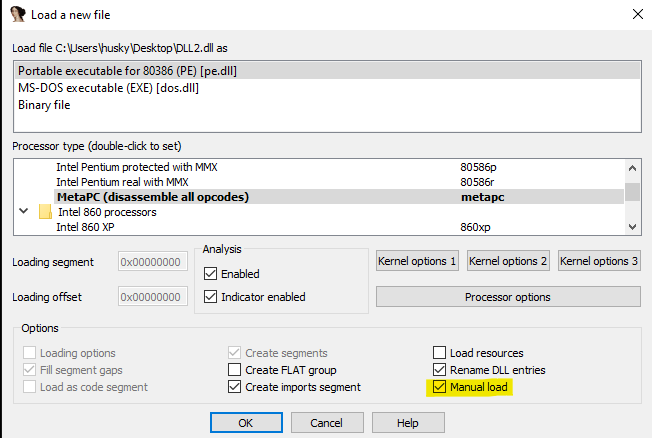
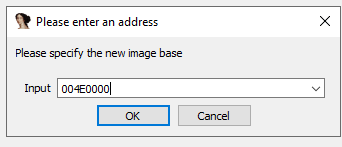
THE END